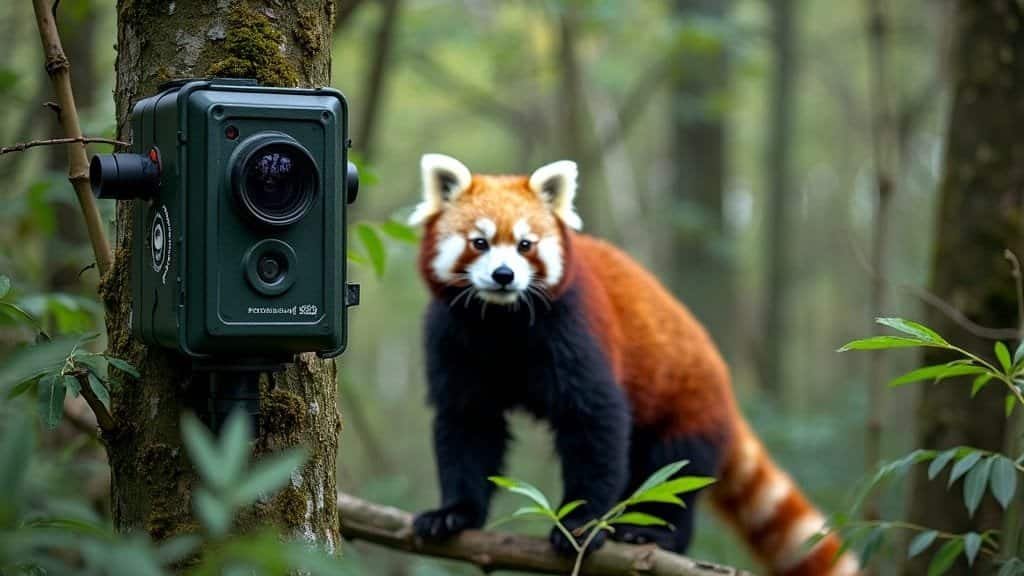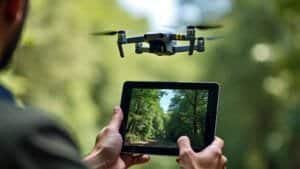Introduction
Camera trap technology has emerged as a game-changing tool in wildlife research, particularly for elusive species like the red panda
These non-invasive devices provide invaluable data on red panda behavior, habitat use, and population trends. By capturing images and videos discreetly in their natural environment, camera traps offer insights that were once difficult to obtain
This article explores the pivotal role of camera traps in red panda research, including their contributions to understanding population densities, uncovering behavioral patterns, and informing conservation strategies
We will also examine the challenges and innovations that shape the future of this technology in wildlife studies
The Role of Camera Traps in Red Panda Research
Camera traps have become indispensable tools for studying red pandas, offering a window into the lives of these elusive animals without disturbing their natural behaviors
By strategically placing cameras in high-altitude forests where red pandas live, researchers can collect continuous data to better understand their ecology and conservation needs
How Camera Traps Function in Forest Environments
Camera traps are typically equipped with motion sensors and infrared capabilities, allowing them to capture images and videos when an animal passes by, regardless of the time of day
For red panda research, these devices are often mounted on trees at elevations that align with the animal’s arboreal habits. In Nepal, for example, researchers have used arboreal camera traps to monitor red pandas in temperate forests with dense bamboo undergrowth
These cameras operate autonomously for weeks or even months, depending on battery life and memory capacity. This extended deployment enables researchers to gather data over a prolonged period, capturing seasonal variations in red panda activity and habitat use
The non-invasive nature of camera traps is particularly advantageous for studying a shy and solitary species like the red panda, as it minimizes human interference
The Benefits of Non-Invasive Monitoring
One of the primary advantages of camera traps is their ability to collect data discreetly. Unlike traditional observational methods that often rely on direct sightings, camera traps eliminate the need for human presence, which can alter animal behavior
This technology has proven especially effective in tracking nocturnal or crepuscular species, such as red pandas, whose activities peak during dawn and dusk
Camera traps also allow researchers to monitor areas that are otherwise difficult to access. Red pandas inhabit rugged terrains and dense forests, making field observations challenging
Camera traps bridge this gap, providing a detailed view of red panda presence across various habitats, from protected reserves to less-explored regions
Expanding Research Through Continuous Observation
The continuous operation of camera traps offers unique opportunities to study long-term ecological patterns
For red pandas, this includes understanding how they respond to environmental changes, such as habitat degradation or shifts in bamboo availability. By analyzing time-stamped images, researchers can assess changes in red panda activity over weeks, months, or even years
In Nepal’s Panchthar-Ilam-Taplejung corridor, for instance, camera traps have been used to document red panda movement between fragmented habitats. This data has been crucial for identifying migration routes and designing habitat corridors to promote connectivity
Similarly, in Bhutan, camera trap studies have highlighted the importance of high-altitude forests as critical habitats for red pandas, influencing conservation policies in the region
Camera traps have transformed the way researchers study red pandas, providing an unobtrusive yet powerful tool for collecting data on this endangered species
Their ability to operate autonomously in challenging environments makes them a cornerstone of modern wildlife research, paving the way for more effective conservation strategies
Insights Into Red Panda Behavior and Ecology
Understanding the behavior and ecological preferences of red pandas is essential for their conservation
Camera traps have significantly enhanced our ability to observe these elusive creatures, offering valuable data on their daily activities, habitat use, and feeding behaviors
Behavioral Patterns Captured by Camera Traps
Camera traps have provided unprecedented insights into the activity patterns of red pandas, revealing their unique behavioral traits. Red pandas are primarily crepuscular, with peaks in activity occurring during dawn and dusk
Studies using camera trap data, such as those conducted in Nepal’s Langtang National Park, have confirmed that red pandas spend a significant portion of their active hours feeding, resting, and navigating through their forested habitats
These devices have also captured social behaviors, such as scent marking, which red pandas use to communicate and establish territory. Camera traps positioned near trees with visible markings have recorded red pandas rubbing their bodies against the bark, a behavior that helps maintain their scent trails and territory boundaries
Such findings contribute to understanding how red pandas interact with their environment and each other, despite being solitary animals
Nocturnal and Diurnal Activity Insights
While red pandas are known for their crepuscular habits, camera traps have shown variations in activity depending on environmental factors
For instance, in areas with high human disturbance, red pandas may shift their activity to nighttime to avoid interactions. This adaptability demonstrates their resilience but also underscores the pressures they face from habitat encroachment
Camera traps have also recorded occasional daytime activity, particularly during colder months when red pandas need to forage more to maintain their energy levels
These findings provide a nuanced view of their behavior, emphasizing the importance of preserving undisturbed habitats where they can maintain their natural rhythms
Habitat Use and Feeding Behaviors
Red pandas rely on specific habitats rich in bamboo, their primary food source. Camera traps have been instrumental in documenting their foraging habits and habitat preferences
Studies in Bhutan, for example, have shown that red pandas frequently select areas with dense bamboo growth and access to water sources. Camera trap footage often captures them climbing bamboo stems or stripping leaves, highlighting the critical role of this plant in their diet
In addition to bamboo, camera traps have documented red pandas consuming fruits, acorns, and occasionally small insects. This dietary flexibility allows them to survive in varying environmental conditions but also points to their dependence on a well-preserved forest ecosystem
These devices have also helped identify red panda resting sites, which are typically in tree hollows or on large branches. Understanding these preferences helps conservationists prioritize areas for habitat protection and restoration, ensuring that red pandas have access to both food and shelter
Camera traps have deepened our understanding of red panda behavior and ecology, revealing the intricacies of their daily lives and their interactions with their environment
These insights are essential for creating effective conservation strategies that align with the species’ natural behaviors and habitat requirements
Population Studies Using Camera Traps
Accurately estimating red panda populations is critical for assessing their conservation status and identifying key areas for protection
Camera traps have revolutionized population studies by providing reliable, non-invasive data on their numbers, movement patterns, and habitat preferences
Estimating Population Densities in Key Regions
Camera traps offer a highly effective method for estimating red panda population densities, particularly in remote and inaccessible areas
Researchers deploy multiple cameras across a grid pattern within a study area, capturing images of red pandas as they move through their natural habitat. By analyzing these images, researchers can use statistical models to estimate population densities
For instance, in Bhutan’s Jigme Dorji National Park, camera trap surveys conducted between 2022 and 2023 identified individual red pandas based on unique markings and activity patterns
The data indicated a stable population density of approximately 0.2 individuals per square kilometer in certain regions. Similar studies in Nepal’s Rara National Park revealed comparable densities, providing valuable benchmarks for conservation efforts
These findings are particularly useful in prioritizing regions for habitat restoration and monitoring. Areas with higher population densities are often designated as core conservation zones, while those with lower densities may require targeted interventions to enhance habitat connectivity
Tracking Movement and Territory Ranges
Camera traps have also provided crucial insights into the movement patterns and territorial ranges of red pandas
By analyzing time-stamped images from multiple camera sites, researchers can track the movement of individual animals over time. This data helps identify their home ranges and preferred pathways, which are critical for designing wildlife corridors
In Nepal’s Panchthar-Ilam-Taplejung corridor, camera trap studies have documented red pandas using forested paths to move between fragmented habitats
These findings underscore the importance of maintaining connectivity between forest patches to support genetic exchange and reduce the risk of inbreeding
Additionally, camera traps have revealed variations in movement patterns based on seasonal changes. During winter, red pandas tend to restrict their movements to areas with abundant bamboo, minimizing energy expenditure
Understanding these patterns allows conservationists to predict their habitat needs during different times of the year
Identifying Habitat Preferences
Red pandas exhibit specific habitat preferences that camera traps have helped elucidate. They thrive in temperate forests with dense undergrowth, abundant bamboo, and access to water. Camera trap data has shown that they favor altitudes between 8,200 and 13,800 feet, although this can vary based on local conditions
In a 2023 study conducted in India’s Singalila National Park, camera traps documented red pandas using habitats with a high canopy cover and minimal human disturbance
Conversely, areas near human settlements showed reduced red panda activity, highlighting the negative impact of habitat encroachment
The ability to map habitat preferences with precision allows conservationists to implement targeted measures, such as protecting critical feeding and resting sites. This information also guides reforestation efforts, ensuring that restored habitats meet the ecological needs of red pandas
Through detailed population studies enabled by camera traps, researchers can better understand the distribution, movement, and habitat requirements of red pandas
This knowledge is fundamental to developing effective conservation strategies that address both immediate threats and long-term challenges
Challenges and Innovations in Camera Trap Technology
While camera traps have significantly advanced red panda research, they come with limitations that must be addressed to maximize their effectiveness
Recent innovations, particularly the integration of artificial intelligence (AI), are helping overcome these challenges, enhancing the scope and accuracy of camera trap studies
Limitations of Traditional Camera Trap Methods
One of the primary challenges of using camera traps in red panda research is their susceptibility to environmental factors. Harsh weather conditions in the high-altitude habitats where red pandas live can damage equipment, disrupt functionality, or reduce battery life
For instance, heavy snowfall and condensation frequently obstruct camera lenses, rendering images unusable
Additionally, false triggers caused by moving vegetation or non-target species can result in a significant amount of unusable data. In dense forests, improper camera placement may also lead to missed detections, particularly for arboreal species like the red panda
These factors can reduce the reliability of data and increase the time required for analysis
Another limitation is the high cost of deploying and maintaining camera traps, especially in large-scale studies. The expense of purchasing equipment, installing cameras in remote locations, and retrieving data can strain conservation budgets, limiting the scope of research efforts
Advancements in AI and Data Processing
Recent technological advancements, particularly in AI and machine learning, are addressing many of the challenges associated with camera trap research
AI-powered image analysis tools can process vast amounts of camera trap data quickly, automatically identifying red pandas and distinguishing them from other species or false triggers
For example, the Wildlife Insights platform, developed in collaboration with Google, has been used to analyze camera trap images from multiple red panda habitats
This system significantly reduces the time required for manual data processing, enabling researchers to focus on interpreting results and developing conservation strategies
AI algorithms also allow for individual identification of red pandas based on unique fur patterns or physical characteristics. This capability is crucial for tracking specific animals over time, improving the accuracy of population density estimates and movement studies
Overcoming Environmental Challenges in Red Panda Habitats
Innovations in camera trap design are making these devices more resilient to environmental challenges. Weatherproof casings, improved battery life, and solar-powered options are now available, ensuring longer deployment periods even in harsh conditions
In high-altitude forests, researchers are experimenting with arboreal camera traps mounted at varying heights to capture the full range of red panda activity. These setups are particularly effective in recording feeding and resting behaviors, which often occur in the forest canopy
Efforts are also underway to develop more cost-effective camera trap models, making the technology accessible to smaller conservation organizations and community-based programs
Collaborations between researchers and technology developers have led to the creation of modular camera traps that can be customized for specific ecological studies, further enhancing their utility
Future Prospects for Camera Trap Technology
The continued evolution of camera trap technology promises to expand its applications in red panda research
Integration with GPS and remote data transmission systems, for example, allows researchers to access data in real time, reducing the need for frequent field visits
Drone-assisted deployment of camera traps is another emerging innovation that could make installation more efficient in remote or inaccessible areas
By addressing the limitations of traditional methods and leveraging new technologies, camera traps are set to play an even more vital role in red panda conservation
These advancements not only improve data quality but also enhance the efficiency and scope of research efforts, ensuring better outcomes for this endangered species
Conclusion
Camera trap technology has fundamentally transformed red panda research, providing a wealth of insights into their behavior, habitat preferences, and population dynamics
These non-invasive tools have proven invaluable for studying this elusive species, enabling researchers to collect data in remote and challenging environments without disturbing their natural behaviors
By capturing detailed information about red panda activity patterns, territory ranges, and habitat use, camera traps have helped identify critical areas for conservation and guided efforts to protect this endangered species
While traditional camera trap methods face challenges such as environmental damage and high costs, recent advancements in artificial intelligence and camera design are addressing these limitations
AI-powered analysis and weather-resistant equipment have enhanced the efficiency and accuracy of data collection, paving the way for more comprehensive studies. Looking forward, innovations like real-time data transmission and drone-assisted deployment promise to further improve the scope of camera trap research
The integration of camera trap findings into conservation strategies has already shown significant benefits, from designing wildlife corridors to preventing habitat fragmentation
As technology continues to evolve, camera traps will remain a cornerstone of red panda research, playing a crucial role in ensuring the survival of this unique and charismatic species





